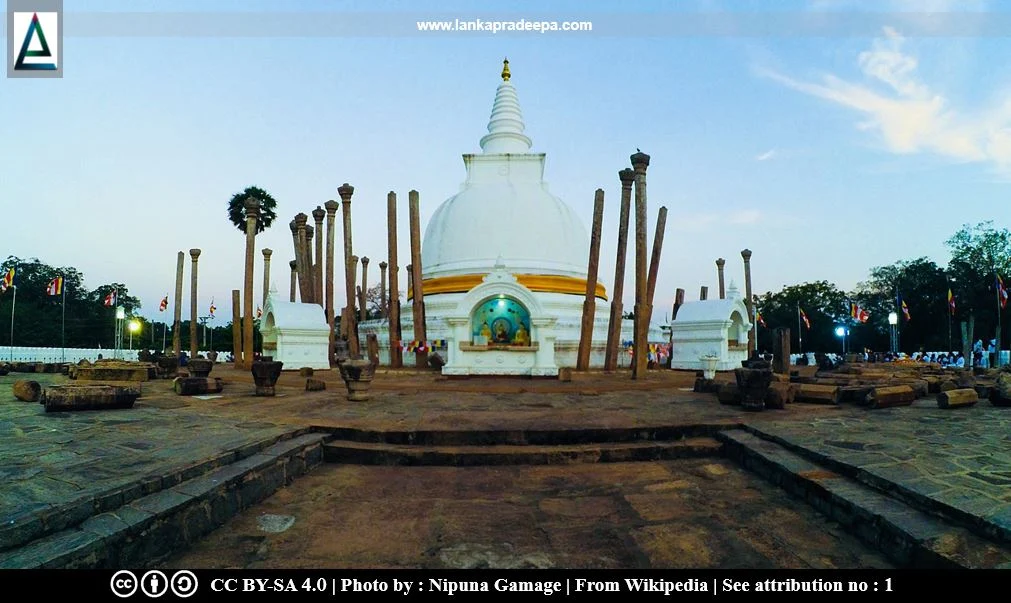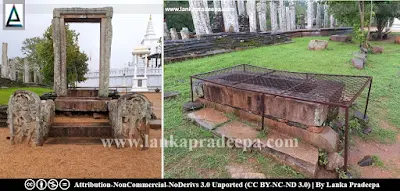
Thuparamaya or Tubaraba (Sinhala: අනුරාධපුර ථූපාරාමය, Tamil: தூபாராமய, அனுராதபுரம்) is an ancient Buddhist monastery complex in Anuradhapura District, Sri Lanka. It is situated about 0.55 km north of the Ruwanweliseya Stupa and near the Abhaya Wewa tank. Thuparama is considered the first historic Stupa with a monastery established in ancient Sri Lanka (Dias, 2001; Wikramagamage, 2004).
History
The history of Thuparamaya goes back to the pre-Christian era. According to chronicles, a temple dedicated to the Yakkha named Maheja had been erected here by King Pandukabhaya (437-367 B.C.), the first monarch of the Anuradhapura Kingdom. Following the introduction of Buddhism to Sri Lanka by Arhat Mahinda Thera, King Devanampiyatissa (247-207 B.C.) built the Thuparama Stupa on this site as the first Buddhist structure in the country (Nicholas, 1963). It is believed that the right collarbone of the Buddha has been enshrined in this Stupa (Dias, 2001; Jayasuriya, 2016; Nicholas, 1963).
The ground where the Stupa was built is said to have been consecrated by the Buddha (Nicholas, 1963). Besides the establishment of the Thuparama Stupa, King Devanampiyatissa also founded a Vihara and planted a sapling of the Bodhi tree at the site (Nicholas, 1963). After that, King Lanjatissa (119-110 B.C.) added a stone mantling to the Stupa in the second century B.C. and a Vatadageya (a Thupaghara - a house for the Stupa) was built for it by King Vasabha (67-111 A.D.) later (Nicholas, 1963).
The ground where the Stupa was built is said to have been consecrated by the Buddha (Nicholas, 1963). Besides the establishment of the Thuparama Stupa, King Devanampiyatissa also founded a Vihara and planted a sapling of the Bodhi tree at the site (Nicholas, 1963). After that, King Lanjatissa (119-110 B.C.) added a stone mantling to the Stupa in the second century B.C. and a Vatadageya (a Thupaghara - a house for the Stupa) was built for it by King Vasabha (67-111 A.D.) later (Nicholas, 1963).
Thereafter, the Stupa received the royal patronage of many successive kings including Gajabahu I (114-136 A.D.), Gotabhaya (249-263 A.D.), Upatissa I (365-406 A.D.), Dhatusena (455-473 A.D.), Aggabodhi II [(604-614 A.D.) Nicholas, 1963]. However, it was robbed in the 7th century A.D. by King Dathopatissa I (639-650 A.D.) but restored again by King Kassapa II [(650-659 A.D.) Nicholas, 1963]. The Stupa was subjected to renovation again by the hands of many kings such as Aggabodhi VI (733-772 A.D.), Mahinda II (777-797 A.D.), Dappula II (815-831 A.D.) until it was plundered by the Pandyans in 840 A.D. (Nicholas, 1963). During the period between the 9th - 10th centuries A.D., the Stupa was developed by King Sena II (853-887 A.D.), Udaya II (887-898 A.D.), Mahinda IV [(956-972 A.D.) Nicholas, 1963]. At the end of the 10th century, the Vihara was completely destroyed by the Cola invaders (Jayasuriya, 2016) but subsequently renovated by King Parakramabahu I [(1153-1186 A.D.) Nicholas, 1963].
Besides the Thuparama Stupa, the other components of the Vihara were developed or
built by several kings including Bhatikabhaya (22-7 B.C.), Amandagamani Abhaya
(19-29 A.D.), Bhatikatissa (143-167 A.D.), Manavamma [(684-718 A.D.) Dias, 2001; Nicholas, 1963].
Inscriptions
Palumekichchawa inscription
An inscription by King Gajabahu I has been found engraved on a rock surface at the Vana (the spillway) of the Palumekichchawa tank (Wickremasinghe. 1912). According to it, King Gamini Abhaya (King Gajabahu I) had spent 5,000 karsapanas on the excavation of the Vadamanaka Tank in the Upala district and granted it to the community of Buddhist monks at the Thuparamaya (Wickremasinghe, 1912).
Thuparama slab inscription of Gajabahu I
Another inscription of Gajabau I was discovered in 1926 while clearing the foundation of the western side of the enclosing wall of the Thuparama Stupa (Paranavitana, 1933). It records that the king had granted certain income taken from Gonagiri-utaviya (a tank or a tract of paddy fields) to the monks of the Ratana Araba monastery (Paranavitana, 1933).
Thuparama slab inscription of Gajabahu I
Another inscription of Gajabau I was discovered in 1926 while clearing the foundation of the western side of the enclosing wall of the Thuparama Stupa (Paranavitana, 1933). It records that the king had granted certain income taken from Gonagiri-utaviya (a tank or a tract of paddy fields) to the monks of the Ratana Araba monastery (Paranavitana, 1933).
Thuparama stone-seat inscription of Nissankamalla
A stone seat containing an inscription of King Nissankamalla (1187-1196 A.D.) has been discovered on the premises of Thuparama Stupa (Ranawella, 2007).
Stupa
The original Thuparama Stupa is said to be in the shape of a heap of paddy (Jayasuriya, 2016; Wikramagamage, 2004). From time to time, the Stupa was renovated by several kings including King Vasabha and King Gotabhaya. King Vasabha is said to have covered the Stupa chamber with a wall of stone and King Gotabhaya subsequently built a relic chamber for it. The last restoration of the Stupa was done in 1862 and as a result of that, the Stupa has taken the shape of a bell.
The present Stupa is 18.9 m in height and has a circumference of 17.7 m (Wikramagamage, 2004).
Cetiyaghara/ Vatadageya
The remaining stone pillars around the Thuparama Stupa indicate that it once had a Cetiyaghara, a house enclosing the Stupa. The roof over the Stupa is not found today but the supportive stone pillars in four concentric circles provide evidence for its existence. The pillars are elegantly carved and fixed to the ground in a symmetric manner.
This Cetiyaghara is believed to be added to the Stupa after the 7th century A.D. (Jayasuriya, 2016).
Artefacts
Bodhisattva Maitreya
This ungilt, bronze statue was discovered at the Thuparama Vatadage complex and is presently on the display at the National Museum of Colombo. The statue is 46.7 cm tall and has been dated to the 9-10th centuries A.D.
The Bodhisattva is standing on a circular-shaped base in a relaxed posture. The body is bent at three places, namely the shoulder, the waist, and the
knee and therefore called a Thivanka (meaning three bends)
statue. The raised right hand of the statue depicts Katakahasta mudra while the lowered left-hand shows Varada mudra. The lower body is covered by a dhoti held in position by moderately used looped sashes. The head is dressed with a bejewelled crown Karandamakuta. The statue is adorned with a number of jewellery including necklaces, bracelets and anklets.

.
See also
#) Anuradhapura Maha Viharaya
Attribution
1) Thuparamaya Stupa by Nipuna Gamage is licensed under CC BY-SA 4.0
References
1) Dias, M, 2001. The growth of Buddhist monastic institutions in Sri
Lanka from Brahmi inscriptions. Epigraphia Zeylanica, Vol. VIII.
Department of Archaeology Survey. ISBN: 955-9264-04-4. p.47.
2) Jayasuriya, E., 2016. A guide to the Cultural Triangle of Sri Lanka. Central Cultural Fund. ISBN: 978-955-613-312-7. pp.51-52.
3) Nicholas, C. W., 1963. Historical topography of ancient and medieval Ceylon. Journal of the Ceylon Branch of the Royal Asiatic
Society, New Series (Vol VI). Special Number: Colombo. Royal Asiatic
Society (Ceylon Branch). pp.131-133.
4) Paranavitana, S., 1933. (Edited and translated by Wickremasinghe, D.M.D.Z.; Codrington, H.W.) Dadigama slab-inscription of Bhuvanekabahu VI. Epigraphia Zeylanica: Being lithic and other inscriptions of Ceylon: Vol. III. Printed at the Department of Government Printing, Sri Lanka (Ceylon) for the Archeological Department. pp.114-119.
5) Ranawella, S., 2007. Inscription of Ceylon. Volume VI. Department of Archaeology. ISBN: 978-955-91-59-61-2. pp.110-111.
4) Paranavitana, S., 1933. (Edited and translated by Wickremasinghe, D.M.D.Z.; Codrington, H.W.) Dadigama slab-inscription of Bhuvanekabahu VI. Epigraphia Zeylanica: Being lithic and other inscriptions of Ceylon: Vol. III. Printed at the Department of Government Printing, Sri Lanka (Ceylon) for the Archeological Department. pp.114-119.
5) Ranawella, S., 2007. Inscription of Ceylon. Volume VI. Department of Archaeology. ISBN: 978-955-91-59-61-2. pp.110-111.
6) Wikramagamage, C., 2004. Heritage of Rajarata: Major natural, cultural and historic sites. Colombo. Central Bank of Sri Lanka. pp.74-79.
7) Wickremasinghe, D. M. D. Z., 1912. Epigraphia Zeylanica: Being lithic and other inscriptions of Ceylon (Vol, I). Published for the government of Ceylon by Henry Frowde. pp.208-211.
Location Map
This page was last updated on 14 January 2023




